And Finally There's ZamboangPrepared by Harold Stephens
Travel Correspondent for Thai Airways International
Last week we traveled to Sandakan in Borneo and Chittagong in Bangladesh. This week it’s Zamboanga, one of my favorite ports in Asia. I visited Zamboanga on several occasions when I was making passages be6ween Asia and the Pacific aboard my schooner Third Sea. Recently I made it by air on a Thai Airways flight to Manila and a connecting flight on Philippines Airline.
So why Zamboanga? What’s the attraction?
Situated at the southwestern tip of Mindanao, on the eastern shore of the Moro Gulf and the Celebes Sea, the port has been the scene of endless historic naval battles and skirmishes over the last four centuries. Time has not changed the waterfront. All sorts of vessels make up the waterfront: Trading vessels from the Sulu Islands, contraband vessels, rusted freighters, passenger ferries from up north, cruise ships, private yachts, government launches and patrol boats, and colourful sailing craft from as far as Borneo.
What a pleasure to sit in a street cafe, order a cold San Miguel and look out at ships at anchor, like watching an old time movie. And here on shore you witness the people of Zamboanga. Christian Filipinos who bear Chinese-Malay features but answer to Spanish names. There are the Moros, the Muslims from the Sulu Islands—a proud race who continues to resist authority from the Manila government—who live by their own code of ethics, and many still believe that by killing a Christian they win a quick transit to Paradise. They fought the Spaniards, they fought the Americans, and they continue to do battle against the Philippine Constabulary. Some of the most colourful of these tribesmen from the Sulu are the Badjaos, often called sea gypsies.
A number of things make Zamboanga exciting. At first appearance it's the old-world architecture, which is part Spanish and part American, and added to this is the Oriental touch. The parks, central plaza and the fort are direct imports from Spain, although they came 400 years ago; the government buildings are American from the days when General "Black Jack" Pershing was governor, and the oriental influence reigns from the Muslim Moros who built the mosques and sail the colourful praus through the straits.
The Badjaos were the first people to call the place Zamboanga, or land of the fragrant flowers. In 1635, the Spanish moved in, kept the name, and fortified the town against possible attack by the Portuguese, British, Dutch and the Sulu pirates. They built a fort and named it Fort Real Fuerza de Nuestra Senora del Pilar de Zaragoza, which, fortunately, was shortened to Fort Pilar. It was captured by the US cavalry in 1899 and held by the Japanese in 1942. The ruins still stand today. In some senses, Zamboanga is a division between the Orient to the west and the Occident to the east.
Getting there, actually, is not difficult or complicated as one might expect. Several international carriers make scheduled flights to Manila and, from there to Zamboanga, it can be two hours by air or 24 by coastal ferry. I was tempted to catch a ferry but in the end opted for a PAL flight.
It can be a beautiful flight above the clouds with some of the finest islands in the Pacific below. You want to explore them all, but you know you can't because there are some 7,000 islands in the Philippines. After flying over mountainous Mindanao, Zamboanga suddenly appears spread out along the southern coast.
From the modern airport it's only a twenty minute drive into town where I checked into the Lantaka on the water front, a modern hotel but with old style charm. Even before having a drink at the bar, I headed out into the streets.
The fort was pretty much destroyed during the war and stands only as a ruin today. Nonetheless, it's an impressive sight and makes a pleasant walk along the crumbled ramparts.
The strongest American influence is seen in the massive, gray-stone City Hall located in city center. Its enormous gates were designed so that a company of mounted cavalry could ride through six abreast.
The building was originally constructed to serve as Provisional Army headquarters and as quarters for staff officers. It was completed in 1907 whereupon General Pershing occupied the building as his residence until he was transferred back to the USA in 1912. A number of American military officers received their early training in the Philippines, from MacArthur to Wainwright and Eisenhower. They all at one time or another made mention in their writings of the Provisional Headquarters building in Zamboanga. We can only imagine some of the gala functions that went on there until it became City Hall after World War II. Some of the old timers around town still talk about it.
A late addition to the tourist attraction in Zamboanga is the "Tree House." The tourist office tries to promote it, and it's really not a bad gimmick for someone (or couples who are married only, please) who like to live for a night or two on a tree top, and all for free. But Zamboanga really doesn't need a gimmick to attract visitors.
Its attractions are its streets and crumbling wall and cafes and the raucous waterfront. The waterfront has no equal in Asia.
Morning is the best time to visit the waterfront, especially the market, where a dozen races come to sell their wares which includes everything from fish to fruit to flowers. I find it best to slip into an old pair of slacks and deck or tennis shoes (so you can feel the pavement and cobble beneath your feet) and walk through the market area and along the sea wall to the main docks. Here, where the Sulu trading boats and freighters tie up, there is a large berthing area behind a wall called the "Barter Traders." Most of the goods behind the barbed wire fence are contraband, smuggled in from Hong Kong and Borneo. It's fun to walk through the area but there's not much to buy unless you have set up house in Zamboanga and want tinned sardines and cheap transistors.
In Zamboanga, seashells command one of the biggest markets in South East Asia. The blue and emerald green seas of the Philippines abound in giant clams, black and finger coral, turtles and shell fish of varied hues and sizes. Fishermen as well as Sulu traders bring them to Zamboanga.
Many travellers are frightened away from the southern Philippines because of the civil disturbances between the rebel Muslims and the central government. It's a condition that has existed for 400 years and it's one that's likely to continue.
I can't recommend visiting the Sulu Islands to the south or venturing inland on Mindanao itself, but Zamboanga is different. The political situation in Zamboanga changes with the tide, and the only sure and safe way for anyone contemplating a visit is to check with the tourist office in Manila. The government doesn't want to lose any tourists and won't authorize anything that isn't safe.
Harold Stephens
Bangkok
E-mail: ROH Weekly Travel (booking@inet.co.th)
Note: The article is the personal view of the writer and does not necessarily reflect the view of Thai Airways International Public Company Limited. | 
US Troops fighting the Moros in 1898 | | 
One of oldest building in Zamboanga | | 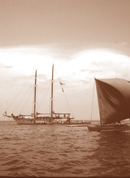
The author’s schooner in Zamboanga | | 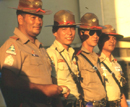
Even the police pose for a photograph | | 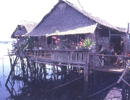
Typical house on stilts | | 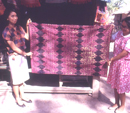
Beautiful cloth at a good price | | 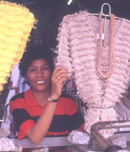
Buy my blouse, she asks | | 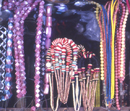
Local jewelry at local prices | | 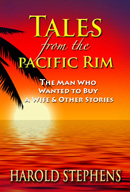
Read more about Zamboanga in the author’s book |
|





